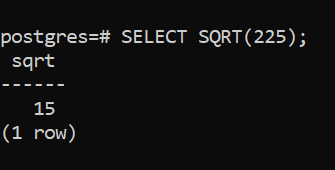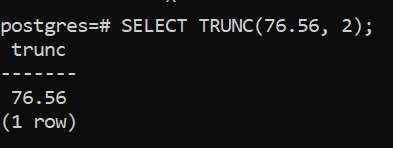Mathematical operations are one of the most important requirements in programming languages and database design. Developers are provided with pre-built tools for manipulating the data. This function makes coding more efficient and accurate. PostgreSQL provides a collection of mathematical functions that enable users to improve data processing. This is the most asked topic in PostgreSQL interviews. In this tutorial, we will learn about these mathematical functions with the help of practical examples.
PostgreSQL Math Functions
PostgreSQL provides developers with a wide range of mathematical functions that handle data types from basic statistics to complex trigonometric calculations. This function contains various functionalities, such as ABS(), CEIL(), FLOOR(), MOD(), ROUND(), TRYNC(), and so on. These functions exhibit high accuracy and efficiency.
List of PostgreSQL Math Functions
1. ABS(number)
Let’s say you have invited a large number of attendees to your party and now want to ensure correct estimates for various aspects of the event. The PostgreSQL ABS() method can be very useful for processing numerical data related to party arrangements. The PostgreSQL ABS() function returns the absolute value of a specified number, which is the number’s distance from zero with NO regard to its sign.
Example
SELECT ABS(-78);Code language: SQL (Structured Query Language) (sql)Output

2. CBRT(number)
Assume you’re arranging a scientific meeting and need to do difficult mathematical computations. You’re now considering utilizing PostgreSQL’s CBRT() function to do certain operations. This functionality enables you to analyze and process numerical data effectively, especially when dealing with volumetric measurements, cubic dimensions, or other situations where cube roots are required. The PostgreSQL CCBRT() function returns the cube root of the specified number.
Example
SELECT CBRT(343);Code language: SQL (Structured Query Language) (sql)Output

3. CEIL(number)
If you manage a financial database and need to round up certain numerical figures for precise financial analysis. You can consider utilizing PostgreSQL’s CEIL() functions to do this task. The PostgreSQL CEIL() function returns the smallest integer value that is greater than or equal to the specified number by the argument.
Example
SELECT CEIL(7.9);Code language: SQL (Structured Query Language) (sql)Output

4. DEGREES(radians)
Suppose you’re working on a geographical mapping project and need to convert radians to degrees. The PostgreSQL function DEGREES() converts the specified number into the degrees. Utilizing PostgreSQL’s DEGREES() function can be turn out as useful to ease this translation.
Example
SELECT DEGREES(.56);Code language: SQL (Structured Query Language) (sql)Output

5. DIV(n,m)
Let’s say you’re creating a software application that divides numbers and wants exact integer quotient results. You are now considering using PostgreSQL’s DIV() function to conduct the division operation. The DIV() function in PostgreSQL splits the two specified numbers and returns the integer quotient.
Example
SELECT DIV(49, 7);Code language: SQL (Structured Query Language) (sql)Output

6. MOD(n,m)
The PostgreSQL MOD() function returns the remainder of dividing n by m. It can be beneficial if you’re creating a software program that needs to calculate remainders from division operations between two integers.
Example
SELECT MOD(91, 3);Code language: SQL (Structured Query Language) (sql)Output

7. EXP(number)
If you’re creating a scientific application or performing statistical analysis that requires exponentiation using the natural constant e. Now you’re thinking about using PostgreSQL’s EXP() function to get the value of e raised to a specific power. The PostgreSQL EXP() function fetches the natural constant e which is raised to the specified power.
Example
SELECT exp(3.0);Code language: SQL (Structured Query Language) (sql)Output

8. FLOOR(number)
Suppose you’re developing a data processing application that requires handling numerical data and rounding down values to the nearest integer. You can consider integrating PostgreSQL’s FLOOR() function to accomplish this task.
Example
SELECT FLOOR(7.9);Code language: SQL (Structured Query Language) (sql)Output

9. LN(number)
Let’s say you’re building a scientific application that requires operation on the natural logarithm of numerical values. Now, you’re considering utilizing PostgreSQL’s LN() function to do this computation. The PostgreSQL function LN() fetches the natural logarithm of a number which is specified by the LN() argument.
Example
SELECT LN(3.0);Code language: SQL (Structured Query Language) (sql)Output

10. LOG(base, number)
The PostgreSQL function fetches the natural logarithm of the number which is specified by the LOG() argument. This can be useful if you need to analyze data exhibiting exponential growth or decay, or if you’re working with probability distributions where logarithmic transformations are common for normalization or statistical modeling.
Example
SELECT LOG(200.0);Code language: SQL (Structured Query Language) (sql)Output

11. ROUND(number, decimals)
Assume you’re creating a financial application that requires exact rounding of numerical quantities for proper computations and reporting. The ROUND() function in PostgreSQL rounds a value to the given number of decimal places. If the decimals parameter is omitted, the function rounds to the nearest whole number. This functionality can ease your task.
Example
SELECT ROUND(98.3723, 2);Code language: SQL (Structured Query Language) (sql)Output

12. RADIANS(degree)
The RADIANS() function in PostgreSQL converts a value specified in degrees to radians and returns the resulting value. This conversion feature is especially beneficial in mathematical and scientific applications where measurements or computations are conducted in radians rather than degrees. The RADIANS() function provides for the smooth integration of angular data into mathematical formulas, trigonometric functions, or geometric computations, resulting in higher precision and consistency.
Example
SELECT RADIANS(16.0);Code language: SQL (Structured Query Language) (sql)Output

13. SIGN(number)
This feature is especially useful in mathematical scenarios where understanding the polarity of numbers is essential for decision-making. The SIGN() function in PostgreSQL returns the sign of a given integer, which is -1 for negative numbers, 0 for zero, and +1 for positive numbers.
Example
SELECT SIGN(-4578);Code language: SQL (Structured Query Language) (sql)Output

14. SQRT(number)
The PostgreSQL SQRT() function returns the square root of a number that is specified. Using the SQRT() method allows for the correct management of numerical data, aiding activities like calculating distances, identifying magnitudes, or solving equations requiring square roots.
Example
SELECT SQRT(225);Code language: SQL (Structured Query Language) (sql)Output

15. TRUNC(number, [decimals])
Assume you’re building a finance application that requires extreme accuracy. You must handle numerical numbers with extreme precision, ensuring that decimal truncation does not jeopardize the validity of your computations. In this case, PostgreSQL’s TRUNC() function comes to the rescue. The PostgreSQL function TRUNC() truncates a number to a number that is specified to decimal places without rounding. It truncates to the nearest whole number if the decimals parameter is omitted.
Example
SELECT TRUNC(76.56, 2);Code language: SQL (Structured Query Language) (sql)Output

Benefits of Using PostgreSQL Math Functions
- Performance Efficiency: PostgreSQL’s mathematical functions are optimized for their performance, allowing developers to perform complex operations directly on the database, reducing the need for external computing.
- Accuracy: PostgreSQL’s mathematical function is designed to provide accurate results, reducing the possibility of errors due to inefficient operation.
- Functionality: PostgreSQL offers a wide range set of mathematical functions, which provides developers with the tools that they need to perform a variety of mathematical tasks directly within the database.
Also Read: PostgreSQL String Functions
Conclusion
PostgreSQL statistical mathematical function offer various benefits such as increased coding efficiency, increased accuracy and their vast range of applications making it a must-have tool for anyone working with PostgreSQL databases. Mastering these functions is important for maximizing the efficiency of PostgreSQL in various data processing tasks. We hope you enjoyed this tutorial.
Reference
https://stackoverflow.com/questions/16441918/postgresql-mathematical-function
